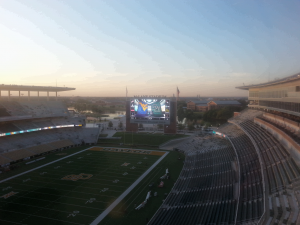WVU v. Baylor: First things in the morning
October 17, 2015 by Mike Casazza
You are looking live at beautiful McLane Stadium, a $266 million recruiting brochure on the Brazos River. This is an impressive place that, perhaps remarkably, looks just like the renderings. I’m not sure how Baylor built it with that budget (actually $250 million at first, but who’s counting?) seeing as if the renovations at Texas A&M’s current stadium cost $485 million. Quite an arms race in these parts. This stadium is festively surrounded, and on three sides you’ll find ample parking lots and tailgates. The fourth side is the open end, which is picturesque as can be with the river, the campus buildings and the fans crossing bridges to get to the stadium.
Baylor’s won a ton of games, praise and prizes the past few years, but this is the program’s biggest move to join the elite.

They haven’t lost here, where they’re 8-0 as part of the NCAA-best 18-game home winning streak, and you wonder for how long they’ll live with a capacity of 45,000. There are plans for future expansion to 55,000, and it would seem the Bears could build atop the highest level of seating because there’s support standing behind the horseshoe. That ought to be enough to add another 10,000, and maybe Baylor one day wants more. In any event, it’d be a shame to close the open end of the stadium or do anything that could compromise that view, which really is the stadium’s signature.
So that’s where we start today, but where the game starts, as far as I’m concerned, is when the drives start. We’re done bowing at the alter of Baylor’s offense this week, but prepare yourself for something significant.
WVU can win and lose this game on Baylor’s first-down plays. The Bears average — let me repeat that for you: average — 10.2 yards per play on first down. A stunning 56.8 percent of their total yards and 24 of 44 touchdowns on offense have come on first down. They have 202 first-down plays and 63 of them have resulted in first downs and two dozen have ended in the end zone.
I know, I know. Baylor. Schedule. Rinse. Repeat. But that’s still amazing. It’s five games, not two, and two of the five were against Big 12 teams — or in the case of Kansas, what passes for a Big 12 team.
(Related: Baylor has faced but 60 third downs in five games and si No. 2 nationally to Texas Tech in conversion percentage with a strapping 55 percent success rate.)
Baylor, No. 2 to nationally to Georgia State in rushing yards per game, averages 7.56 yards per carry on first down — and consider how that’s skewed by snaps from backups with mops. Good luck stopping this offense on second-and-2.
But good luck stopping it on first-and-10. They run it more on first down (116 snaps to 86), but the Bears average 20.4 yards per completion and 13.7 yards per attempt on first-down passes with 18 touchdowns.
Now, this is not a brand new concept. Baylor’s as rhythm as an offense gets, and the schedule has to start on first down. The Bears were not as staggeringly successful on first down before the WVU game last season, but the No. 4-ranked team in the country was oftentimes found moving the ball as it wanted when it wanted.
On 36 first-down snaps in Morgantown last fall, Baylor had eight plays go more 8 or more yards and only six result in a first down. The Bears had 73 yards on 22 first-down rushes, 102 yards on 13 first-down passes (eight completions) and one loss of 7 yards on a first-down sack. That’s 3.3 yards per carry, 6.8 yards per pass play and 12.8 yards per completion on first down. In all, Tony Gibson unplugged the juggernaut by limiting Baylor to 4.7 yards per play on first down.
Recipe?

